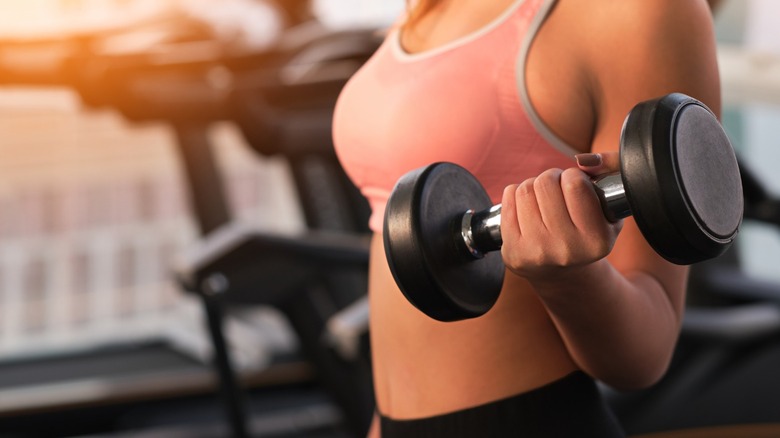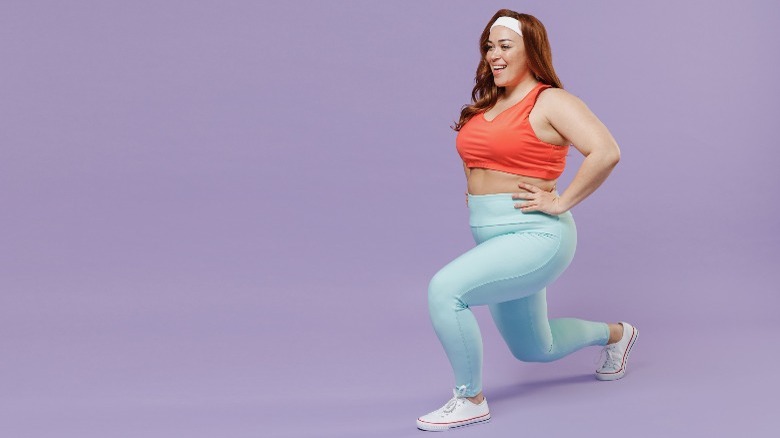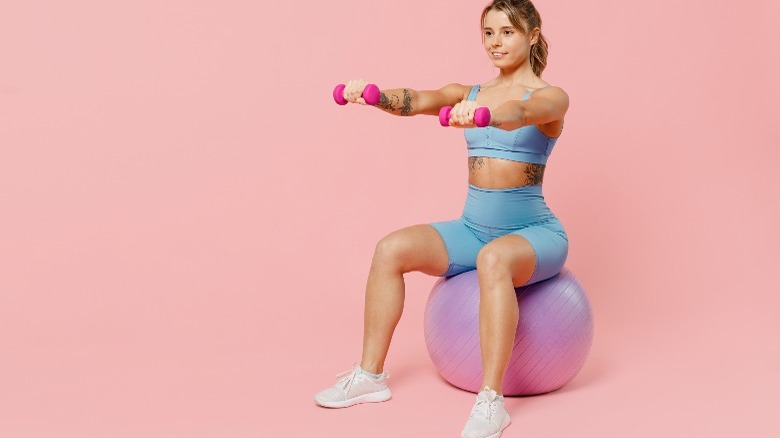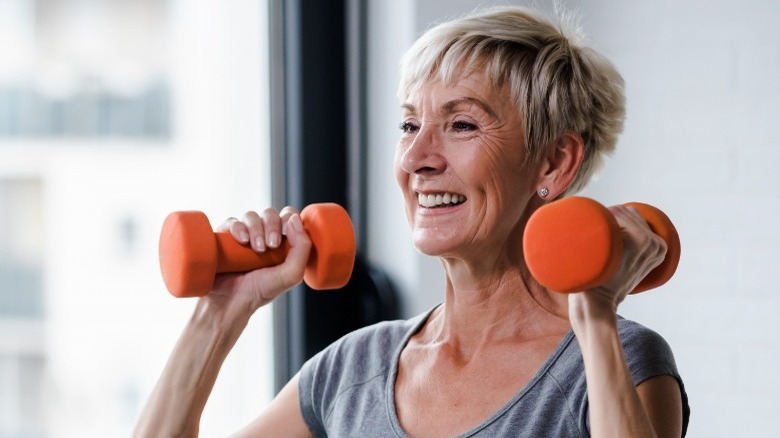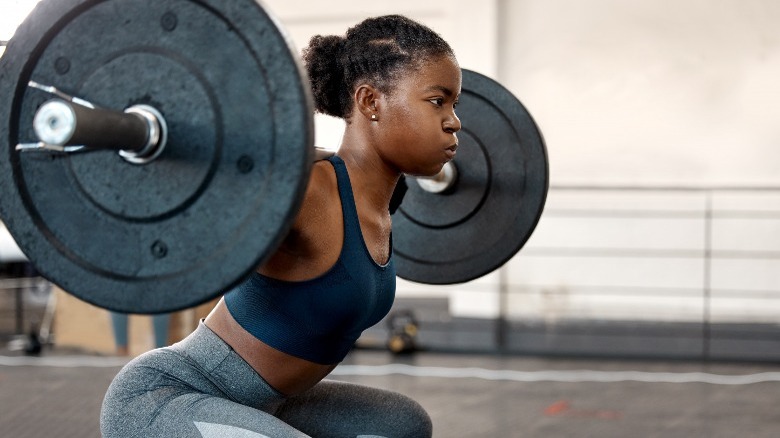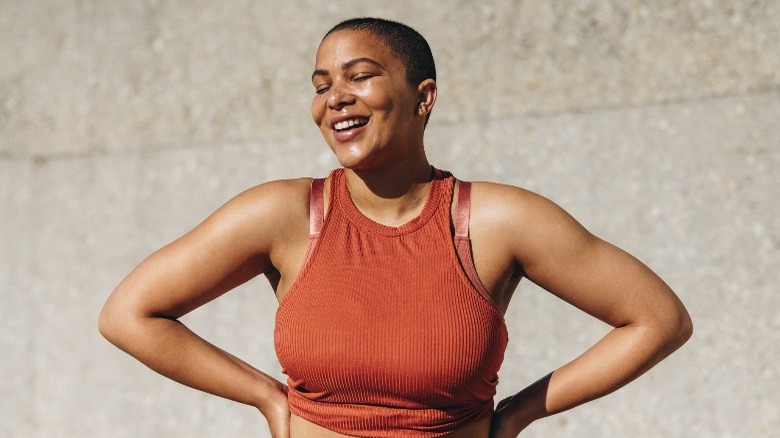How To Choose The Right Size Weights For Your Fitness Goals
While the term "fitness journey" seems cliché, there is some truth to the expression. Throughout your exercise regimen, you may experience setbacks, successes, and plateaus that require you to make changes along the way. And of course, what works for one person might not work for another. Everybody has different needs, goals, and abilities when it comes to exercise that should be taken into consideration as you build your circuit. This is not to say you should limit yourself. However, when you're ready for a challenge, you do it knowing what your limits are and the best practices to push them safely.
One aspect of your workout that is sure to change as you set out to achieve your fitness goals is your the weights you use for strength work. For beginners, it can be tough to know your baseline, as well as when to know if you're ready to switch to something heavier. This process is called progressive overload — adding more weight, repetition, or mileage to your exercises over time. It is the key to both building muscle and to turning your exercise practice into a proper training session in which you work toward achieving your fitness goals.
But before we get ahead, let's start with the basics. Here's how to choose the right size weights for your workout.
Begin with bodyweight
As we mentioned, weights are not one-size-fits-all. Everyone steps into the gym with different levels of fitness and exercise experience. So, if you are completely new to the world of weightlifting, you should kickstart your strength circuit using your body weight alone so that you can get used to the movements without causing injury.
There are several benefits to bodyweight exercises. First, you will be able to gauge which muscle groups feel challenged and where you feel you can push yourself further. Perhaps your legs feel solid, but your core catches on fire! This is great information to know as you progress. Second, bodyweight exercises emphasize form. Before you add weights to your workout, it is important that you have your form down to both avoid injuring yourself and to get the most out of your exercises.
Bodyweight exercises can also be completed in the convenience of your home, so you don't need any special equipment or a pricy gym membership to get going. Still, you might wonder: Are bodyweight exercises actually effective? The answer is a resounding yes, especially when incorporated into a high-intensity interval training (HIIT) workout. HIIT workouts are known to burn fat, reduce blood pressure, and improve insulin resistance, among other benefits, per Healthline. Exercises that can be done without weights include squats, lunges, planks, pushups, burpees, and more.
Start light when incorporating weights
When you feel ready to add dumbells or kettlebells to your routine, make sure to start light. What "light" means depends on the person. You can figure out what's right for you by paying attention to how you feel. Can you maintain good form when completing your reps? Can you complete all of the sets with the light weights and not just one? Can you feel the weight, and if so, does it feel too challenging for the set? If the answer is yes, you're probably using the right amount of weight.
Also keep in mind that, depending on the exercise you're doing, you might want to use lighter or heavier weights to achieve an optimal workout. For example, tricep workouts typically involve a lighter set of weights for beginners, as they can be challenging to perform while keeping proper form. Exercises that involve light weights can be used to build endurance, meaning a higher number of reps per set, roughly around 12.
It's important to note that if you work through your set with perfect form and reps to spare, your weights are probably too light. Therefore, it's wise to continue to check in on how your light weights feel when you exercise, as they could indicate that you're ready for more. Light weights can also be incorporated into many bodyweight exercises that you have already mastered. For example, plank pull-throughs and lunges of all kinds, including curtsy or side lunges, with light weights in hand can add extra intensity.
As a reminder, always remember to stretch before lifting weights.
Build to moderate weights
Moderate weights are ones that are not too light but not too heavy. They are used for exercises that include a moderate number of reps per set, roughly around 10, and should involve more effort on your part to get to through the set than using light weights.
Between sets, you should rest for no more than one minute before continuing on to the next with the same weights until you've finished. Your final set should feel like a challenge, but you should be able to maintain good form. One thing to keep in mind is that the exact number of reps completed is more or less arbitrary as long as you are putting tension on your muscles over time, practicing good form, and allowing time for recovery. Treat repetitions like guidelines for you to measure your progress as you start rather than as a hard line between progress and failure.
Moderate weights are great for hypertrophy, which is where your body begins building muscle. Some exercises you can try safely with a moderate weight are one-arm dumbbell rows and weighted glue bridges. To continue toward progressive overload, you want to add no more than 10% of the weight to your exercises each week, maintaining the same amount of reps and sets as before, if possible. If a new weight feels too challenging, you can always drop back down to a lower weight.
Know your heavy weights
There are few things as rewarding as realizing you are stronger than you thought you were. Lifting weights is not only good for your physique, but a study published in the Journal of Applied Psychology showed that lifting weights can be good for your brain too. Lifting heavier weights can feel challenging and uncomfortable both physically and mentally, but it's worth it to reach new fitness heights.
When looking for a set of heavy weights that work for you, it's not just about building muscle but about increasing overall strength. While the two tend to go hand-in-hand, the difference is that building strength pertains to your muscle performance, whereas hypertrophy refers to building the size of your muscle.
Self recommends choosing a heavy weight that allows you to perform between two and six reps per set. Exercises that typically involve a heavier set of weights include compound exercises such as squats and deadlifts, both of which utilize the larger muscles in your body. You'll know been lifting heavy when you feel sore the next day. However, should you feel any pain either post-workout or during, it's best to take a step back, assess if you might be injured, and adjust your routine accordingly.
Prioritizing recovery
Ensuring that your body is properly recovering is essential to both the quality of your workout and the longevity of your fitness training. Completing some form of active recovery, whether its foam rolling, stretching, going for a walk, or doing some light exercise like jumping jacks, can help with muscle soreness as well as keep your mind and body connected when you're not in the gym.
Ensuring that you're eating well, including foods that are high in protein and complex carbs, helps your body recover the strength you've exerted, as does drinking enough water every day. Getting between seven and nine hours of sleep per night is also crucial to your body's recovery, per Web MD. In addition to reenergizing your body, rest is also pivotal for your mental health.
Don't forget that you set your own pace when it comes to your workouts. Keep in mind that when it comes to weight ranges, there is no standard as to what constitutes a light, moderate, and heavy weight — it is all dependent on your individual capabilities. There are many different sets of weights on the market; a standard set might include dumbbells between five and 50 pounds with increment increases of five pounds. It is best to give yourself a wide range of weight possibilities to experiment with as you begin. When beginning a new workout routine, you may also want to consult a licensed professional or personal trainer who can help you safely accomplish your goals.
